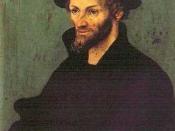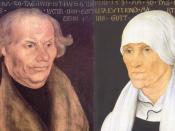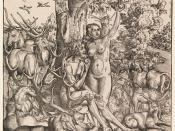Ben Stonebraker
April 28, 2014
6th hour
It is said, "Every age projects its own image of man into its art." In every era, mankind takes its view of itself, and projects it into art. Techniques change, but art remains faceted on human culture. Sculptures or paintings, the medium continued to have the view of man of that age. Throughout the Renaissance, Reformation Years, the Industrial Revolution, and the interwar years, man projects its own image into its art.
During the 15th and 16th century, man displayed the Renaissance image of man in its art. Structured around humanism, individualism, secularism, and fascination of antiquity, the Renaissance focused on the glory man, and the person as an individual. Previously, in the medieval times, all art had been focused on religious subjects or scenes, such as the Virgin Mary, Jesus, etc. The image of man as a servant was present in medieval art, such as in Procession of Saint Gregory. In this, the pope leads a procession of followers through the city, as many are falling ill. The focus on the religious does not dignify man, rather it focuses on the people praying, as if to put the focus on man serving God instead of man serving man. In the Renaissance, the focus of art shifted to man, whether it was a portrait, sculpture, or a scene in which individuals doing various activities. The Renaissance stressed the importance and the value of the individual, and saw the individual as one who could accomplish great things. In The Last Supper, Leonardo da Vinci paints a scene in which Jesus and his disciples are gathered around a table, Jesus sitting in the middle. While the picture places Jesus at the center, as if he was the main subject, da Vinci places emphasis...


